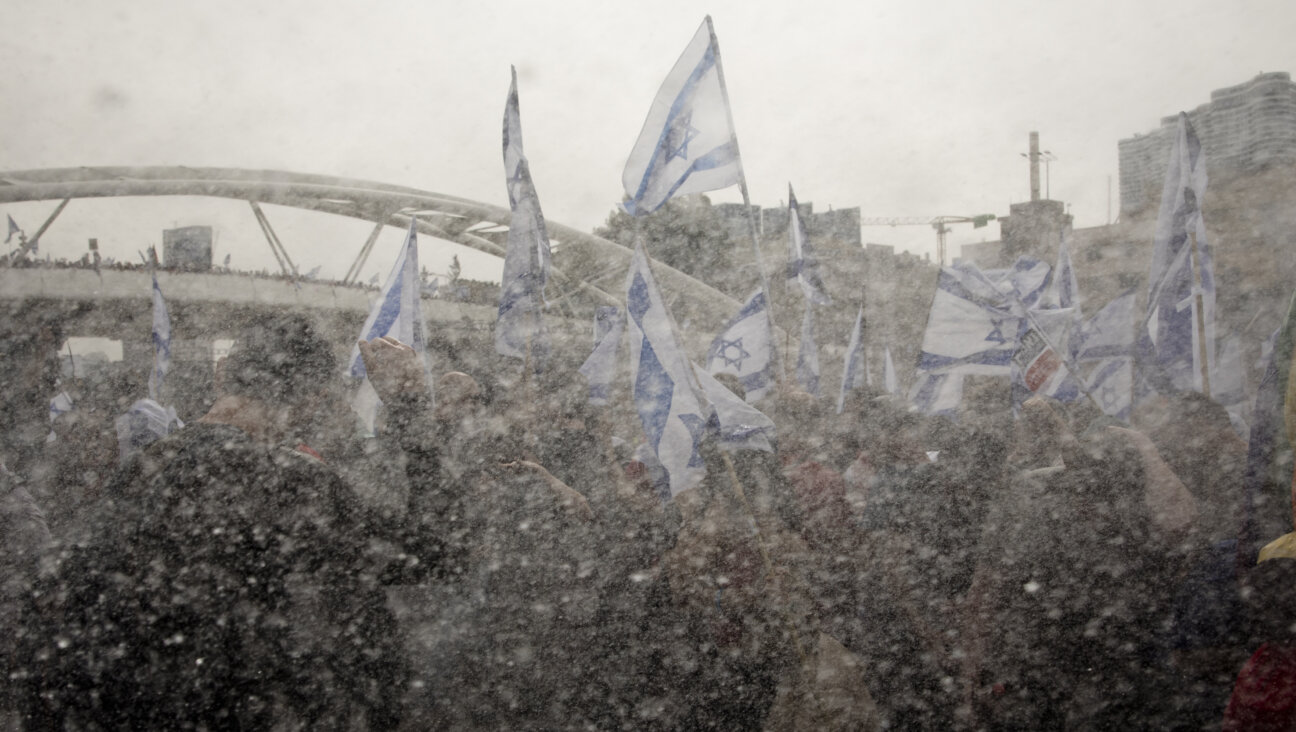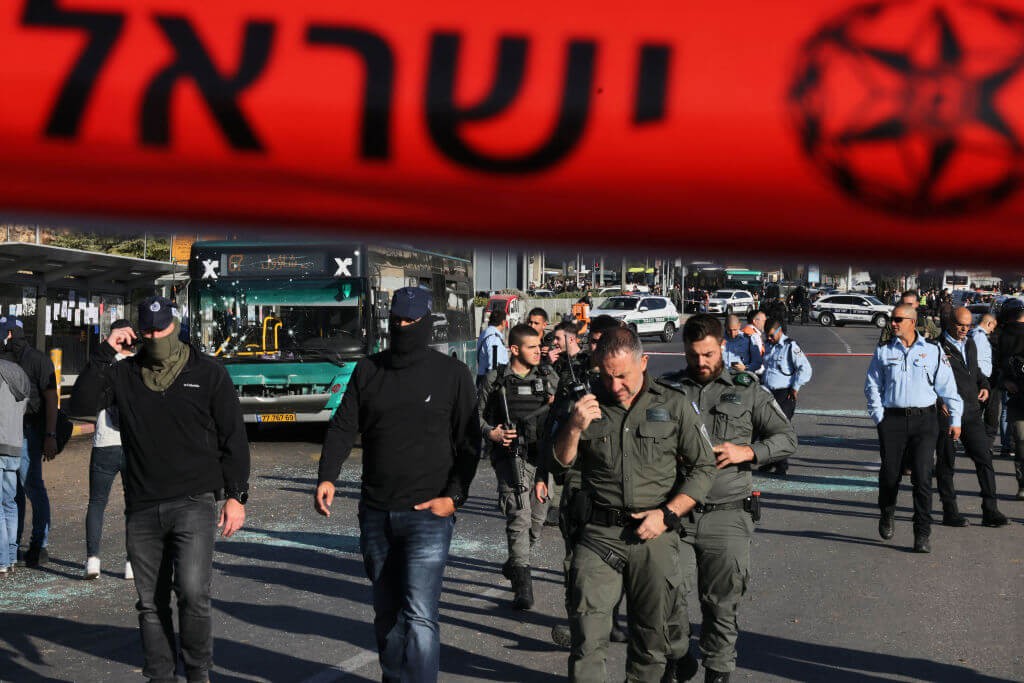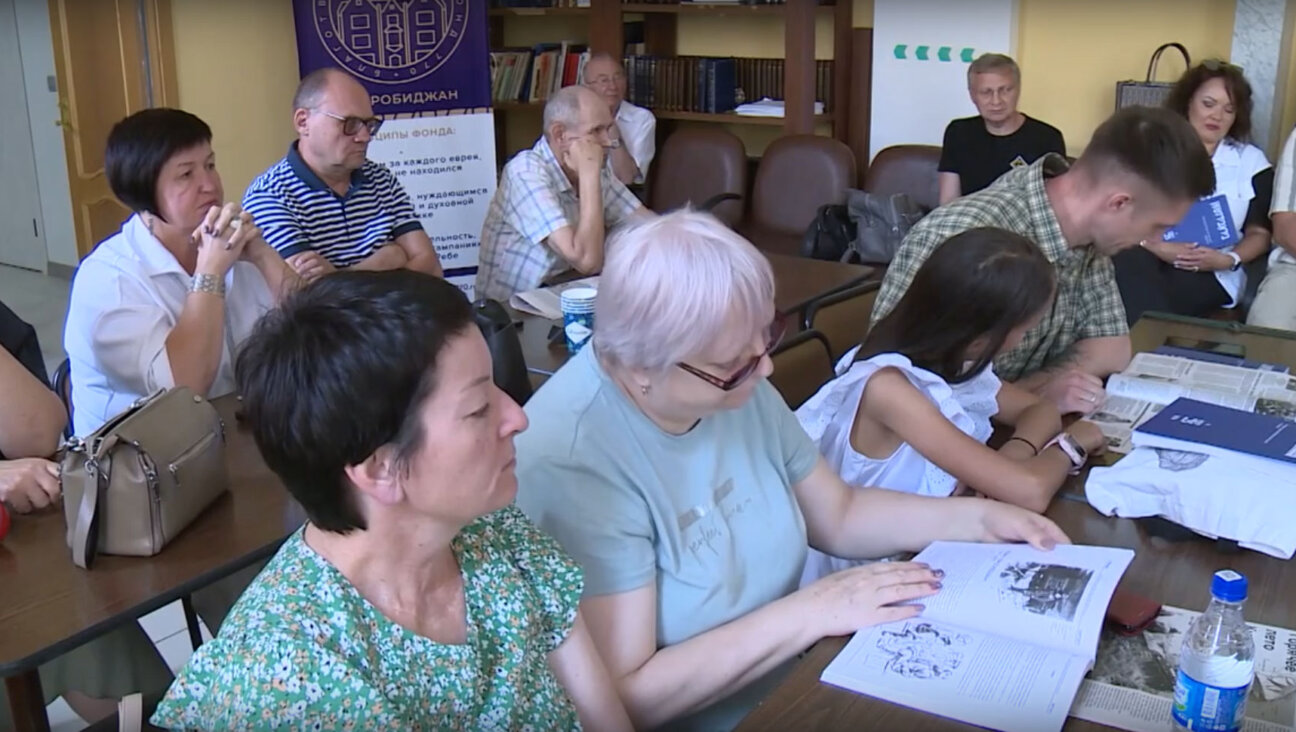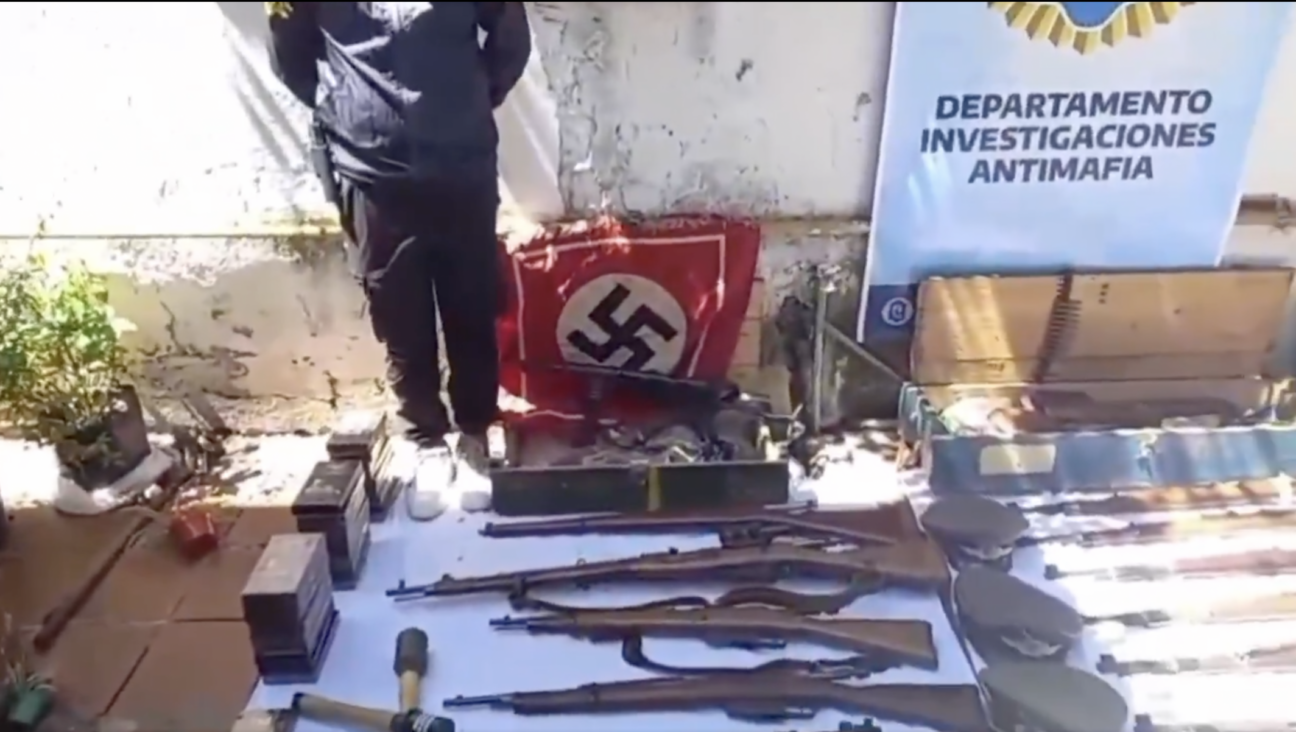Iconic Mideast Photo Is a Fake — and Heartbreaking One at That
Staged: Ricki Rosen’s photograph meant to depict an Israeli boy and a Palestinian boy in Jerusalem has been reproduced hundreds of times. Image by Ricki Rosen
One week into Israel’s war with Gaza this past summer, superstar Rihanna tweeted a photo of an Israeli boy and a Palestinian boy with their arms around each other facing away from the camera: “Let’s pray for peace and a swift end to the Israeli-Palestinian conflict!” she wrote. “Is there any hope?….”
The photo was posted as damage control after the pop star tweeted — and then eight minutes later deleted — the hashtag #FreePalestine. That initial tweet provoked an immediate barrage from Israel advocates on Twitter asking if she supported Hamas. It’s not clear to what degree the photo mollified her critics. But what Rihanna didn’t know was that the photo is actually a fake.
The boys in the picture aren’t an Israeli and a Palestinian, but two Israeli Jews.
Read: The Iconic Mideast Photo That Isn’t a Fake
The 1993 photo, taken three months after the signing of the Oslo Accords, is one of the most iconic pictures from the Israeli-Palestinian conflict. In it, a boy in a red shirt with a yarmulke and a boy in a black shirt and a keffiyeh walk with their arms slung over each other’s shoulders. Though the background is blurry, they are clearly in the white and green environs of Jerusalem, meandering on a dirt path to an unknown destination. They appear to be lost in conversation, oblivious to the photographer behind them.
In addition to Rihanna’s tweet — which was retweeted by 46,000 people — the photograph has been reproduced hundreds of times on the Internet, appearing in the American Jewish magazine Tikkun, on the web site of the Israel advocacy group Jerusalem Institute of Justice, on various American and Israeli news sites and Facebook pages, and even on the blog belonging to Jack Kornfield, one of the most prominent Buddhists in America.
Yet unlike the other famous pictures documenting the Israeli-Palestinian conflict — such as the 1967 photo of three Israeli soldiers at the Western Wall, or the 1993 shot of Yasser Arafat and Yitzhak Rabin shaking hands on the White House lawn — the photo of the two boys is purely allegorical. With their backs to the camera, the boys are anonymous stand-ins for all Israelis and Palestinians. Set against the backdrop of one of the oldest cities on earth, the picture has a timeless quality. It’s a depiction of what might have been, and what could be in the future, in spite of today’s moribund peace process.
It’s also completely staged.
“I think I felt awkward about it,” said the boy in the yarmulke, speaking now some 21 years later as an adult.

All Grown Up: Zvi Shapiro (left), now 32, wore the kippah in the famous photo. Zemer Aloni (right), now 33, wore the keffiyeh. Image by Courtesy
The Israeli boy in the yarmulke is Zvi Shapiro, the son of two secular American-Israelis. The Palestinian boy is Zemer Aloni, an Israeli Jew. The only real aspect of the photo is that the boys were indeed friends and that the picture was taken in their Jerusalem neighborhood of Abu Tor, which straddles the 1949 armistice line and contains both a Jewish and an Arab section. The boys grew up on the Jewish side of the neighborhood, and while they both recall interactions with Palestinians, neither counted close friends on the other side of the line.
The picture was taken by Ricki Rosen, an American photojournalist who has been covering the Israeli-Palestinian conflict for 26 years. Rosen snapped the photo on assignment for Maclean’s, the national news magazine of Canada, for a cover story about the Oslo Peace Accords. Rosen said that the magazine’s art director was so specific in what he wanted that he even drew her a picture — one boy in a yarmulke, the other in a keffiyeh shot from the back walking down a long road, which was supposed to symbolize the road to peace. He didn’t care whether the boys were actually Israelis or Palestinians, nor did it occur to him that the Palestinian’s keffiyeh would be styled in a way more typical for elderly Palestinian men than for young boys.
“It was a symbolic illustration,” said Rosen. “It was never supposed to be a documentary photo.” She also took other real-life photos for the same article.
Rosen, who also lived in Abu Tor, asked her neighbor Haim Shapiro, then a reporter for the Jerusalem Post, if he would be willing to volunteer his young son for the Jewish boy in the assignment. “If there was any place to find a Palestinian kid who would agree to do this, it would have been Abu Tor,” said Rosen. “But I didn’t look because I thought it would be a very difficult thing. The relations had completely broken down after the first intifada, and Palestinians were very fearful of being seen as collaborating with Israelis because collaborators were being killed.” Instead, Zvi Shapiro’s best friend Zemer Aloni, who lived a block away, would wear the keffiyeh. Aloni said that the fact that he has “Eastern roots” — his father is an Iranian Jew — made him an appropriate choice for the job.
On the day of the shoot, Rosen brought a keffiyeh that she used to leave on her dashboard on reporting trips to the West Bank during the first intifada — a safeguard against her vehicle being pelted by stones and Molotov cocktails — and dressed 12-year-old Aloni in it. Zvi Shapiro, then 11, donned a yarmulke, and the two went for a walk on the nearby Sherover Promenade.
“Ricki told us to just talk to each other,” said Shaprio. “It’s also funny because I don’t think we would have necessarily put our arms around each other the way we are.” Rosen shot several images of the pair that day, including one from the front that is rarely reproduced.

Keen Eye: Ricki Rosen has been photographing the Israeli-Palestinian conflict for 26 years. Image by Courtesy
In 2002, the photo was digitized as part of Rosen’s collection on Corbis Images, a Seattle-based company that manages licensing for editorial and creative photographs. On the Corbis web site, there is no indication that the photograph is fake; it is categorized as a stock image under “News.” Yet even though the photo is copyrighted, the vast majority of the reproductions online — Rihanna’s included — have occurred without Rosen’s or Corbis’s knowledge or permission. On some sites, such as that of Tikkun, the photograph is credited as Creative Commons, meaning anyone can use it — a categorization to which Rosen never agreed. Without control over where the image appears, Rosen said, she is unable to explain to those who would use it that the photo is staged. Nor has she been properly compensated for her work.
It wasn’t until after Rihanna tweeted the photo and Zvi Shapiro’s mother brought it to Rosen’s attention that she realized how many people were posting the image without her consent. She said that Corbis is looking into Rihanna’s usage on her behalf. If Rosen is not financially compensated, she said. “I want her to retweet it with my credit and say, ‘I am sorry for stealing the intellectual property of another artist.’” She would also like Rihanna to explain that the photo isn’t really of a Palestinian and an Israeli kid, but is meant to represent “the hopes then for peace down the road.”
After the photo shoot, Shapiro and Aloni remained close friends for a few years but began to drift apart in middle school. Shapiro said that the last time he saw Aloni was when they were both in the army and they ran into each other at a coffee shop, a meeting Aloni did not recall. Shapiro, now 32, said that his experience in the army — he was stationed in Jerusalem during the Palestinian suicide bombing campaign in the second intifada — left him wanting to go to a “place that was the least like Israel as I could find.” Rather than travel to India or South America, like many Israelis do after the army, he enrolled in Bowdoin College in Brunswick, Maine. He is now completing a doctoral program in child clinical psychology at Pennsylvania State University. Married to a woman who does not speak Hebrew, he does not know if or when he will return to Israel.
After Aloni’s army service, he was trained as an architect at Bezalel Academy of Arts and Design in Jerusalem. Now 33, he is working as an architect in Nahalal, near Haifa, where he lives with his wife. Aloni said that looking back on the photo, he had no qualms about appearing as a Palestinian. “I don’t see Arabs as the enemy,” he said. “If someone told me I looked like an Arab, I wouldn’t care. It’s not something to be ashamed of.” When asked whether some Palestinians might consider the outfit degrading — akin to blackface in America — he said he had never considered the issue in that light. “America is much more politically correct about stuff than here.”
Shapiro, on the other hand, said that the racial aspect of the photo now strikes him as “really, really strange.”
“I think it’s probably less acceptable today than it was then,” he said. Because he’s not religious, he also felt like a bit of an imposter wearing a yarmulke. “It’s really not me in the picture, but it’s even less him,” he said of Aloni.
“One of the things I feel about it is just kind of sad,” said Shapiro. “There was a brief period where it didn’t seem as far-fetched as it does now. And it could have just been my naivete as a child, but I felt it almost symbolizes something that we have lost and that I hope we can regain. I think there is a genuine belief that if there is a peaceful solution there can be not only peace but camaraderie and real friendship.”
Aloni called the image a “wishful thinking picture.” He added, “Then it was almost a reality, and now it is like a vision.”
Contact Naomi Zeveloff at [email protected] or on Twitter @naomizeveloff
A message from our CEO & publisher Rachel Fishman Feddersen

I hope you appreciated this article. Before you go, I’d like to ask you to please support the Forward’s award-winning, nonprofit journalism during this critical time.
We’ve set a goal to raise $260,000 by December 31. That’s an ambitious goal, but one that will give us the resources we need to invest in the high quality news, opinion, analysis and cultural coverage that isn’t available anywhere else.
If you feel inspired to make an impact, now is the time to give something back. Join us as a member at your most generous level.
— Rachel Fishman Feddersen, Publisher and CEO























